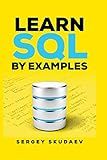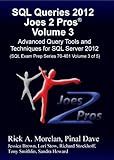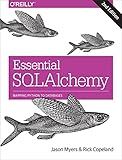Best Tools to Query SQLite 3 in Go to Buy in January 2026

Learn SQL by Examples: Examples of SQL Queries and Stored Procedures for MySQL and Oracle



Beginning SQL 2012 Joes 2 Pros: The SQL Queries 2012 Hands-On Tutorial for Beginners (SQL Exam Prep Series)
- AFFORDABLE PRICES ON QUALITY USED BOOKS FOR BUDGET-SAVVY READERS!
- SUSTAINABILITY: REDUCE WASTE BY CHOOSING PRE-LOVED READING MATERIAL.
- UNIQUE FINDS: DISCOVER RARE TITLES AND HIDDEN GEMS AT GREAT DEALS!



SQL Queries 2012 Joes 2 Pros® Volume 3: Advanced Query Tools and Techniques for SQL Server 2012 (SQL Exam Prep Series 70-461 Volume 3 of 5)



SQL Queries 2012 Joes 2 Pros® Volume 2: The SQL Query Techniques Tutorial for SQL Server 2012 (SQL Exam Prep Series 70-461 Volume 2 of 5)



My Programming Notes: SQLAlchemy 2.0: Query relational databases with Python



Essential SQLAlchemy: Mapping Python to Databases


To query into SQLite3 in Golang, you can follow these steps:
- Import the necessary packages:
import ( "database/sql" _ "github.com/mattn/go-sqlite3" )
This imports the required SQLite3 driver package and the SQL package.
- Open a database connection:
db, err := sql.Open("sqlite3", "path/to/database.db") if err != nil { panic(err) } defer db.Close()
Replace "path/to/database.db" with the path to your SQLite database file. Ensure to defer the closing of the database connection to ensure it gets closed properly.
- Prepare the SQL query:
stmt, err := db.Prepare("SELECT * FROM TableName WHERE condition = ?") if err != nil { panic(err) } defer stmt.Close()
Replace "TableName" with the name of the table you want to query from. Replace "condition" with the desired filtering condition.
- Execute the query:
rows, err := stmt.Query("value") if err != nil { panic(err) } defer rows.Close()
Replace "value" with the actual value you want to use for the query.
- Process the query results:
for rows.Next() { var column1, column2 string err = rows.Scan(&column1, &column2) if err != nil { panic(err) } // Process retrieved data }
Replace "column1" and "column2" with the actual names of the columns you want to retrieve. Adjust the variable types as per your usage.
- Check for any errors during iteration:
if err = rows.Err(); err != nil { panic(err) }
That's it! You have successfully queried an SQLite3 database in Golang.
How to perform an INNER JOIN query in SQLite 3 using Golang?
To perform an INNER JOIN query in SQLite 3 using Golang, you can follow these steps:
- Import the necessary packages:
import ( "database/sql" "fmt" _ "github.com/mattn/go-sqlite3" )
- Open a connection to the SQLite database:
db, err := sql.Open("sqlite3", "path/to/database.db") if err != nil { fmt.Println(err) return } defer db.Close()
- Prepare the SQL query with the INNER JOIN clause and placeholders for any parameters:
stmt, err := db.Prepare("SELECT column_name(s) FROM table1 INNER JOIN table2 ON condition") if err != nil { fmt.Println(err) return } defer stmt.Close()
Replace column_name(s) with the names of the columns you want to select, table1 and table2 with the names of the tables to be joined, and condition with the join condition.
- Execute the query and retrieve the result set:
rows, err := stmt.Query() if err != nil { fmt.Println(err) return } defer rows.Close()
- Iterate over the result set to access the queried data:
for rows.Next() { // Use rows.Scan to retrieve the values from each column var col1, col2 string err = rows.Scan(&col1, &col2) if err != nil { fmt.Println(err) return }
// Do something with the retrieved data
fmt.Println(col1, col2)
}
That's it! You have successfully performed an INNER JOIN query in SQLite 3 using Golang. Make sure to handle any potential errors that may occur during the process.
How to handle NULL values when querying into SQLite 3 using Golang?
When querying SQLite 3 using Golang, you can handle NULL values by using the database/sql package's Scan() method. Here's an example of how you can handle NULL values when querying SQLite 3 using Golang:
- Open the database connection and prepare the query:
db, err := sql.Open("sqlite3", "your_database.db") if err != nil { // handle error } defer db.Close()
query := "SELECT column_name FROM your_table WHERE condition=?"
stmt, err := db.Prepare(query) if err != nil { // handle error } defer stmt.Close()
- Execute the query and retrieve the result:
// Assuming you have a placeholder for the condition value conditionValue := "something"
rows, err := stmt.Query(conditionValue) if err != nil { // handle error } defer rows.Close()
for rows.Next() { var columnValue sql.NullString // Use sql.NullString for nullable strings
err = rows.Scan(&columnValue)
if err != nil {
// handle error
}
if columnValue.Valid {
// The value is not NULL
value := columnValue.String
// Process the value
} else {
// The value is NULL
// Handle NULL value scenario
}
}
err = rows.Err() if err != nil { // handle error }
In the above example, we use the sql.NullString type for nullable string values. Similarly, you can use sql.NullInt64, sql.NullFloat64, sql.NullBool, etc., depending on the type of the column you are querying.
By checking the columnValue.Valid field, you can determine whether the value is NULL or not. If columnValue.Valid is true, the value is not NULL, and you can access it using columnValue.String.
Remember to handle any potential errors when scanning or executing the query to ensure your application's robustness.
How to retrieve all rows from a table in SQLite 3 using Golang?
To retrieve all rows from a table in SQLite 3 using Golang, you can use the database/sql package along with the SQLite driver github.com/mattn/go-sqlite3. Here's an example:
package main
import ( "database/sql" "fmt"
\_ "github.com/mattn/go-sqlite3"
)
type User struct { ID int Username string Email string }
func main() { // Open connection to the SQLite database file db, err := sql.Open("sqlite3", "/path/to/database.sqlite") if err != nil { panic(err) } defer db.Close()
// Query all rows from the table
rows, err := db.Query("SELECT \* FROM users")
if err != nil {
panic(err)
}
defer rows.Close()
// Iterate over the rows and print data
var users \[\]User
for rows.Next() {
var user User
err := rows.Scan(&user.ID, &user.Username, &user.Email)
if err != nil {
panic(err)
}
users = append(users, user)
}
// Check for any errors during iteration
err = rows.Err()
if err != nil {
panic(err)
}
// Print all retrieved rows
for \_, user := range users {
fmt.Println(user)
}
}
Make sure to replace /path/to/database.sqlite with the actual path to your SQLite database file, and users with the actual name of your table.
What is the syntax to perform an aggregate function in SQLite 3 using Golang?
To perform an aggregate function in SQLite 3 using Golang, you can use the following syntax:
package main
import ( "database/sql" "fmt"
\_ "github.com/mattn/go-sqlite3"
)
func main() { db, err := sql.Open("sqlite3", "your_database_file_path.db") if err != nil { fmt.Println(err) return } defer db.Close()
rows, err := db.Query("SELECT COUNT(column\_name) FROM table\_name")
if err != nil {
fmt.Println(err)
return
}
defer rows.Close()
var count int
if rows.Next() {
err = rows.Scan(&count)
if err != nil {
fmt.Println(err)
return
}
}
fmt.Println("Count:", count)
}
Note: Replace "your_database_file_path.db" with the actual path to your SQLite database file, "column_name" with the name of the column you want to count, and "table_name" with the name of the table containing the column. You can modify the SQL query to use other aggregate functions like SUM, AVG, MAX, etc., as per your requirement.
How to perform an UPDATE query in SQLite 3 using Golang?
To perform an UPDATE query in SQLite 3 using Golang, you can use the Exec method of the *sql.DB object. Here's an example of how to do it:
- Import the required packages:
import ( "database/sql" _ "github.com/mattn/go-sqlite3" )
- Open a connection to the SQLite database:
db, err := sql.Open("sqlite3", "your_database.db") if err != nil { log.Fatal(err) } defer db.Close()
- Prepare the SQL statement with placeholders for the parameters to be updated:
stmt, err := db.Prepare("UPDATE table_name SET column1 = ?, column2 = ? WHERE condition_column = ?") if err != nil { log.Fatal(err) } defer stmt.Close()
- Execute the UPDATE query by passing the actual values for the parameters:
_, err = stmt.Exec(value1, value2, condition_value) if err != nil { log.Fatal(err) }
Here, value1 and value2 are the new values you want to set for column1 and column2 respectively, and condition_value is the value that helps identify the row you want to update based on the condition_column.
Note that the Exec method returns the number of rows affected by the update operation. In the example, _ is used to ignore the returned value since we are not interested in it.
Make sure to handle any potential errors that may occur during the process.
What is the function to retrieve the last inserted ID in SQLite 3 using Golang?
In SQLite 3, you can retrieve the last inserted ID by using the LastInsertRowID() function in Golang. Here is an example of how to use it:
package main
import ( "database/sql" "fmt" "log"
\_ "github.com/mattn/go-sqlite3" // SQLite3 driver
)
func main() { db, err := sql.Open("sqlite3", "my-database.db") if err != nil { log.Fatal(err) } defer db.Close()
// Insert a record into a table
result, err := db.Exec("INSERT INTO my\_table (column1, column2) VALUES (?, ?)", "value1", "value2")
if err != nil {
log.Fatal(err)
}
// Get the last inserted ID
lastID, err := result.LastInsertId()
if err != nil {
log.Fatal(err)
}
fmt.Println("Last inserted ID:", lastID)
}
In this example, the last inserted ID is obtained through result.LastInsertId(). Make sure to import the SQLite3 driver using _ "github.com/mattn/go-sqlite3" before using it.
